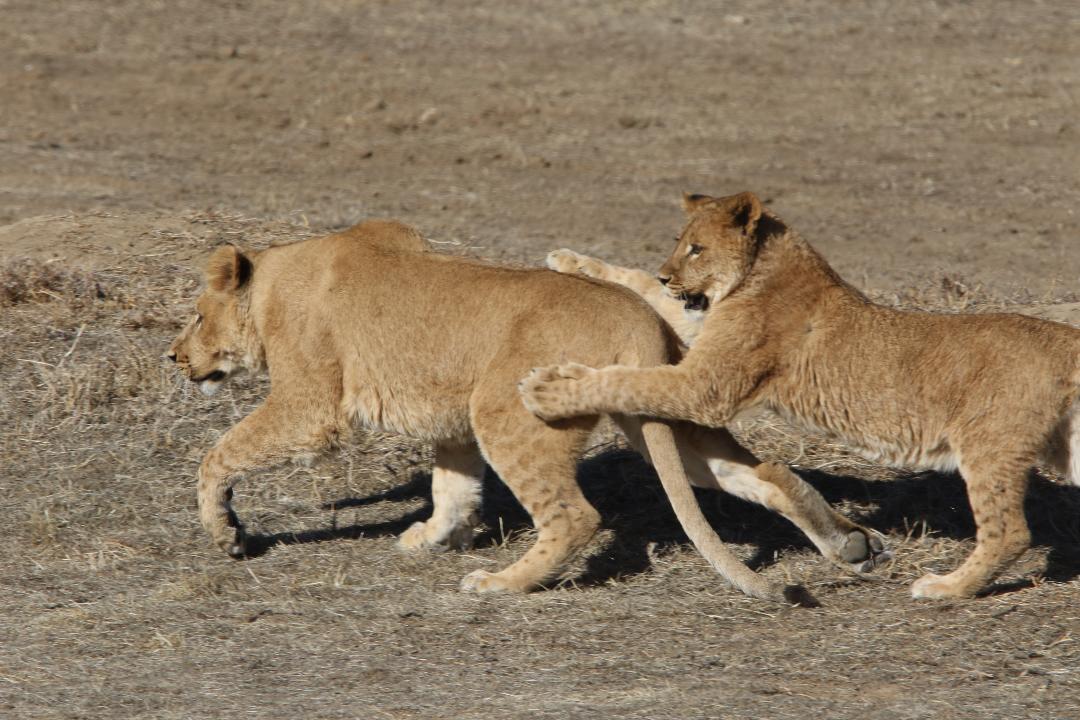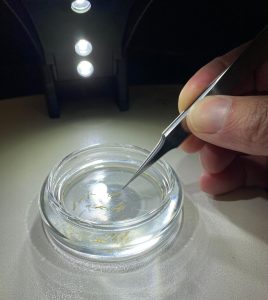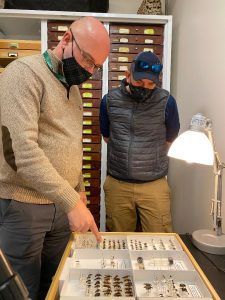
By Callie Hietala
The PETA (People for the Ethical Treatment of Animals) Foundation needed help gaining insight into the death of a lion, and they found it in Martinsville at the Virginia Museum of Natural History (VMNH).
When concluded, research and testimony by Dr. Kal Ivanov and Dr. Joe Keiper, both of the museum, helped resolve a case brought by PETA against Jeff Lowe, best known for his appearance in the Netflix documentary series, “Tiger King: Murder, Mayhem, and Madness.”
Lowe, a former business partner of series star Joseph Maldonado-Passage (better known as “Joe Exotic”), had four lions—Amelia, Leo, Nala, and Kahari—in his care at the Greater Wynnewood Exotic Zoo in Wynnewood, OK. Lowe took over ownership of the zoo from Maldonado-Passage in 2018.
Asher Smith, director of litigation for the PETA Foundation, said that less than 2 days before he was scheduled to help oversee the transfer of the four lions, he was contacted by Lowe’s attorney and told that one of the lions, Kahari, had died.
Smith said Lowe filed a notice in an Indiana federal court stating that the lion had died more than two weeks before, having apparently been poisoned after a nighttime break-in at his facility.
According to a U.S. District Court document filed in the Southern District of Indiana, Lowe stated that a park employee and Lowe’s wife both observed all four lions “to be playful and of good health” on August 30, 2020.
That night, it stated, Lowe’s “property was broken into, including kicking in the door to the animal nursery on the property.” The next morning, Kahari was found dead.
“Upon further investigation of the lion’s cage, a dart was found within the housing of the cage. It is suspected whoever kicked in the door to the animal nursery also shot or otherwise caused a dart to inject poison into the lion,” the document stated.

A pathology report, completed by Oklahoma State University’s College of Veterinary Medicine the afternoon after the alleged poisoning, was included in Lowe’s filing, according to Smith, who said the report, dated Aug. 31, 2020, found no signs of poison or, “because Kahari’s body was so thoroughly decomposed,” any other signs of death.
“The only data we had,” Smith said, “was a reference in the pathology report to ‘the presence of small blow fly larvae up to 10 millimeters long.’ Lawyers are a bunch of humanities students, so it didn’t occur to us that it was important. But one of our animal welfare experts told us it was strange, since these bugs were too large for Lowe’s timeline to make sense, and that we needed to find a ‘bug guy’ to talk about a field we’d never heard of called forensic entomology.”
Smith turned to Google. Given PETA’s Virginia-based headquarters, one of the first search results was VMNH, “which yielded two experts, Dr. Kal Ivanov and Dr. Joe Keiper, with exactly the experience and knowledge we needed,” he said.
Smith initially reached out to Ivanov, the museum’s associate curator of recent invertebrates, for help with the case. Ivanov said he had good knowledge of entomology but limited forensic experience, and reached out to Keiper, who had a more extensive forensic entomology background, having previously consulted on cases for the Cuyahoga County Coroner’s Office, the Akron Police Department, and the F.B.I.
Looking at the information they were initially presented, “we decided we could certainly help,” Ivanov said.
Ivanov said Smith provided several documents containing information about the case, including Lowe’s testimony about the event and the necropsy report.
“They asked us, based upon the insect evidence, ‘can you lay a timeline over the crime scene and see if their story matches the physical evidence?’” Keiper said. “And we said yes.”
Keiper said several elements of that report seemed to contradict Lowe’s account of events, including the level of decomposition, which seemed too advanced for such a short period of time.
Though neither is an expert in animal physiology, “we’ve looked at decomposing animals of all sorts including humans, including large animals, and we know when you start to get organs liquefying, it should be a matter of a couple or three days, not that they last saw the animal (alive) yesterday afternoon. There’s not enough time elapsed.”
Additionally, the size of the blow fly larvae found on the lion gave the entomologists a clue about the blow flies’ stage of development, which in turn helped them estimate when the lion died.
Ivanov and Keiper said they made some “very conservative estimates” about how long it could take the maggots to reach the 5-10 millimeter stage noted in the necropsy report. They concluded that “not nearly enough time elapsed” to support the claim that the lion was alive on Aug. 30, and discovered dead the next morning.
Keiper and Ivanov examined hourly data from a weather station near the zoo to build an accumulated degree hour (ADH) model. “Blow flies grow at a rate that’s well-known and very consistent,” he said. Given hourly weather data and the size of the blow fly larvae, “we can tell you the approximate time of death of an animal or human based on the size and stage of development of the blow fly maggots.”

Keiper and Ivanov explained that, once an animal dies, blow flies move in during the day (they do not lay eggs at night), and lay eggs within hours or even minutes following death.
“This was very straightforward,” Keiper said. “You’ve got an animal that’s outside with no building to prevent bugs from gaining access to the body, we’ve got a weather station nearby that can provide us reliable information about the local climate, and we have a DVM (doctor of veterinary medicine). We trust that she knows what 5 to 10 millimeters looks like.”
The size of the larvae allowed them to determine, at a minimum, how far along the larvae were in their life stages. Applying their ADH model to the growth of the maggots based on the local climate, Ivanov and Keiper determined that Kahari likely died at least the morning of the alleged break-in, more likely the day before or even earlier, meaning that the claims that Kahari was alive and even playful the evening of Aug. 30 were highly unlikely to be true.
Ultimately, Keiper presented their findings to an Oklahoma judge via Zoom in early February. Lowe did not appear at the trial to challenge any of the evidence presented against him. U.S. District Judge Stephen Friot ruled in PETA’s favor.
“For reasons including the size of insects found on Kahari’s body during her necropsy,” Friot wrote in his findings of fact, “Kahari did not die at the approximate date and time Lowe reported.
“Although Lowe claimed a break-in occurred at his facility and that Kahari was poisoned during the break in, the evidence establishes that Kahari was not poisoned during such a break-in, or at all,” the document stated.
Elsewhere in his findings, Friot describes the conditions Kahari and her siblings endured under Lowe’s care.
The four lions were denied “adequate nutrition,” and fed a diet of Kitten Milk Replacer—used for domestic cats—for the first four months they were in Lowe’s care, according to the report. Once the lions transitioned to eating meat, they were fed “rancid, nutrient-deficient meat, which was their only food source.”
This failure to provide adequate nutrition to the lions “was a cause of painful, injurious bone deformities, injuries to the lions’ growth and immune systems, and other preventable injuries,” the document stated.
One of the conditions suffered by the lions was “fly-strike,” described in the document as “a self-perpetuating condition in which flies, seeking blood and tissue, bite and penetrate the skin of an animal, and lay eggs, which hatch maggots which start eating the animal’s flesh.”
Lowe, the court found, failed to take readily-available measures to prevent fly-strike and even exacerbated the problem by “leaving carcasses of recently deceased big cats in the open air near the four lions and having no fly traps.”
The injuries suffered by the lions were treated by a sole veterinarian with “no training or experience in the care of exotic animals, including the lions,” the document said. “The lions were provided inappropriate medications, and medications at inappropriate dosages.”
Additionally, the lions were not provided with adequate enclosures or enrichment, and were placed in “small, virtually barren enclosures which lacked sufficient environmental features, shelters, or enhancements.”
Lowe was found liable under the Endangered Species Act (ESA) for the “appalling cruelty” of the four lions, according to court documents and Smith, who said “Joe and Kal’s help was critical” in the case.
“The premise of captive animal litigation under the Endangered Species Act is that each of these animals matter as individuals—under the law, their individual needs, welfare, and lives demand respect. We owed it to Kahari, even after ensuring her siblings’ transfer to a properly accredited sanctuary, to legally establish that” the “mistreatment killed her, and that this was illegal,” Smith said.
“Joe and Kal helped us do exactly that, winning us a decision that found, for reasons including the size of the insects found on Kahari, she did not die at the date and time Lowe reported and that the evidence establishes Kahari was not poisoned,” he said. “Their contribution to our victory goes even deeper, though. Their professionalism and expertise were invaluable in helping show the judge that our entire case was credible, and had to be taken seriously.”
“A finding of liability under the Endangered Species Act will follow Lowe for the rest of his life,” Smith said. “In a narrow sense, the order ties up a loose end by establishing Lowe has no more rights to these specific lions. A finding of liability also prevents Lowe from engaging in some business activities with respect to other animals, including lions.
“The Endangered Species Act is also what’s known as a fee-shifting law—PETA won more than $700,000 in fees against Lowe’s co-defendants in Indiana, and in the coming weeks PETA will submit its fee request to the Oklahoma federal court,” Smith said.
As to the other lions that were removed, Smith said he still receives regular updates, and understands that they are “currently thriving in their new homes at properly accredited sanctuaries in Arkansas and Colorado.”
One of Kahari’s siblings, “who was emaciated and couldn’t walk when she arrived at the sanctuary, just received a good to excellent prognosis at her last vet checkup,” he said.




